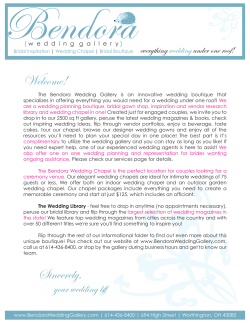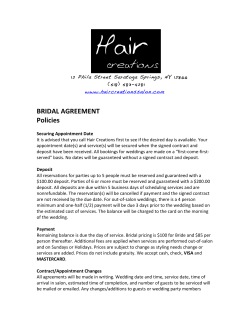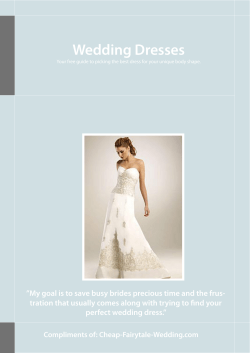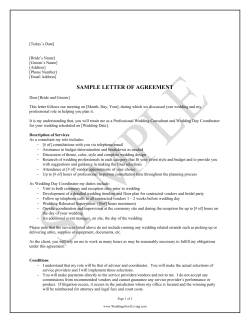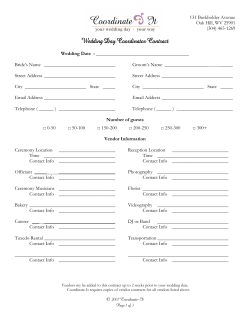
T H E W E D D I N G
Wedding Dresses JKT F-Furt:Wedding Dresses JKT Ffurt x2 28/9/10 12:41 Page 1 E DW I N A E H R M A N is Curator of Textiles and Fashion at the V&A. She is a specialist in nineteenth-century fashion with a particular interest in London. 400 Years of Fashion Natalie Rothstein Jewels and Jewellery Clare Phillips Printed in Xxxxxx THE WEDDING DRESS Underwear: Fashion in Detail Eleri Lynn 3 0 Y E A R S O F B R I DA L FA S H I O N S Also available from V&A Publishing: E DW I N A EHRMAN V&A Publishing Victoria and Albert Museum South Kensington London SW7 2RL www.vandabooks.com THE WEDDING DRESS THE WEDDING DRESS F 300 YEARS O F B R I DA L FA S H I O N S Edwina Ehrman EW GARMENTS are chosen with as much care as wedding dresses. The wedding dress is an expression of the bride-tobe’s identity but some women invest their dress with almost magical qualities seeing the right choice as a talisman of their future happiness. It is a symbol of love and commitment and of the beginning of a new phase in a woman’s life. Wedding dresses also reflect the societies and cultures that created and preserved them and this sumptuous book draws on surviving wedding garments in the V&A’s collection, photographs, letters, memoirs, newspaper accounts and genealogical research to explore the history of the wedding dress and the traditions that have developed around it from 1700 to the present day. It focuses on the white wedding dress which became fashionable in the early nineteenth century and is worn today by women across the world. The book considers the way couturiers and designers have challenged and refreshed the traditional white wedding dress and the influence of the wedding industry, whose antecedents lie in the commercialization of the wedding in Victorian Britain. TheWedding Dress is not only about costume, but also about the cultivation of the image of the bride. This book is a tribute to an exquisite, stylish, glamorous gown, the romance of its evolution and the splendour of its design. £30.00 Wedding Dress 1 pp1-37 v4:Wedding Dress 1 pp1-37 v4 6/1/11 14:36 Page 2 THE WEDDING DRESS 300 YEARS OF BRIDAL FASHIONS Edwina Ehrman V&A PUBLISHING Wedding Dress 1 pp1-37 v4:Wedding Dress 1 pp1-37 v4 6/1/11 14:36 Page 4 CONTENTS First published by V&A Publishing, 2011 V&A Publishing Victoria and Albert Museum South Kensington London SW7 2RL Introduction CHAPTER 1 Distributed in North America by Harry N. Abrams, Inc., New York Silver and White 1700–90 © The Board of Trustees of the Victoria and Albert Museum, 2011 The moral right of the authors has been asserted. CHAPTER 2 Hardback edition ISBN 978 1 85177 632 0 The White Wedding Dress 1790–1840 Library of Congress Control Number XXXXXXX 10 9 8 7 6 5 4 3 2 1 2015 2014 2013 2012 2011 CHAPTER 3 A catalogue record for this book is available from the British Library. All rights reserved. No part of this publication may be reproduced, stored in a retrieval system, or transmitted in any form or by any means electronic, mechanical, photocopying, recording or otherwise, without written permission of the publishers. Every effort has been made to seek permission to reproduce those images whose copyright does not reside with the V&A, and we are grateful to the individuals and institutions who have assisted in this task. Any omissions are entirely unintentional, and the details should be addressed to V&A Publishing. Designer: Nigel Soper Copy-editor: Mark Kilfoyle Index: Vicki Robinson New photography by Richard Davis, V&A Photographic Studio Front jacket illustration: Cotton organdie wedding dress designed by Hardy Amies for the Cotton Board, 1953. Photograph by John French. (c) V&A Images. Back jacket illustration: Jean Paul Gaultier, Haute Couture Spring/Summer 2010 (c) Anthea Sims Photography Frontispiece: Wedding dress, 1950s. Photograph by Lillian Bassman. V&A: PH.12–1986 p.6: Wedding favour. Wax, cloth, paper and silk, British, 1889. V&A: T.266A–1971. Given by Mrs V.I. Lewin Printed in XXXX 7 A working-class wedding Commercializing the White Wedding 1840–1914 Too old for white 21 39 60 63 96 CHAPTER 4 Towards the Modern 1914–45 To wed in red 99 126 CHAPTER 5 Ready-to-Wear 1945–90 A civil wedding 129 158 CHAPTER 6 Choosing White 1990s to the present 161 Wedding Garments in the V&A Glossary Notes Further Reading Acknowledgements Index 188 198 199 203 203 204 Wedding Dress 1 pp1-37 v4:Wedding Dress 1 pp1-37 v4 6/1/11 14:36 Page 8 2 Silk satin wedding dress (front and back) by Norman Hartnell, London, 1933. Margaret Whigham commissioned the dress from the celebrated couturier for her marriage to Charles Sweeny on 21 February 1933. V&A: T.836–1974. Given and worn by Margaret, Duchess of Argyll 1 Margaret Whigham and Charles Sweeny, 1933. Darlings of the gossip columns, the glamorous couple brought traffic to a standstill when they married at London’s Brompton Oratory. As Duchess of Argyll, Whigham would later be the subject of a notorious divorce case. © Hulton-Deutsch Collection / CORBIS tigious and fashionable bridal colours until white became the colour of choice in the early nineteenth century. As the dominant religion in Britain and France (whose bridal fashions influenced those worn in Britain for most of the period the book covers), Christianity’s association of white with innocence and purity was an important symbolic factor. Even today, in Britain’s increasingly secular society, the white wedding dress has lingering connotations of virginity. White garments were associated with spiritual rites of passage long before they became conventional for bridal wear. Babies have been dressed in white robes for the sacrament of baptism when they are initiated into the Christian faith since the eighteenth century. The choice of white garments may be linked to the pre-Reformation use of the white chrisom-cloth, which was placed on the baby’s head or wrapped around its body after baptism and symbolized its innocence.4 Children who died within a month of baptism were buried in the chrisom-cloth, and white 8 THE WEDDING DRESS INTRODUCTION 9 Wedding Dress 1 pp1-37 v4:Wedding Dress 1 pp1-37 v4 6/1/11 14:36 Page 16 10 African wedding in Costa do Sol, Maputo, Mozambique, 2004. The spread of Christianity has encouraged many African brides to wear white wedding dresses. Photograph by Corina Gertz. © Corina Gertz 11 Japanese wedding at Kaiyukan Aquarium Maki and Nobuyuki Tamanishi, Osaka, 29 July 2006. The white wedding dress has become a global phenomenon. Japanese brides often hire a white dress as one of several outfits to wear during the course of their marriage celebrations. © 2006 AFP / Getty Images duce something more idiosyncratic, making more personal juxtapositions and annotating the images. Whatever form they take, photographs also become a material part of a family’s history. Turning the pages of a wedding album or handling a specially framed photograph that marks the occasion can create a powerful tangible link between past and present. Weddings and wedding dresses remain a perennial cultural interest. Every year newspapers and magazines feature articles about weddings. They frequently cite the latest statistics about marriage in modern Britain. According to the Office for National Statistics the provisional number of marriages registered in England and Wales in 2008 was 232,990. (When the full figure is known this is expected to rise by up to 1%.) This is the lowest marriage rate since it was first calculated in 1862. However the divorce rate is at its lowest rate since 1979, suggesting that those who choose to marry are more committed to making it work.11 For women who decide to marry in church rather than in a registry office, wearing white symbol- 16 THE WEDDING DRESS 12 British wedding in Wiltshire, Edward and Nina Tryon, Church of St Mary and St Nicholas, Wilton, 19 July 2008. Philip Treacy designed the bride’s headdress and Vivienne Westwood her dress. Photograph by Kevin Davies. © Kevin Davies izes their commitment to marriage but also fulfils an emotional need, making them feel like a bride embarking on a new phase of their life. Women who have worn white for their weddings talk about its romantic, fairy-tale appeal and talismanic qualities, but above all of how it miraculously transformed them into a bride. In the nineteenth and early twentieth centuries, the white wedding dress was the preserve of well-to-do women in Europe and the USA, but today it is worn by brides of many faiths across the world to celebrate their marriages (pls 10–15). The commercialization of weddings, particularly in the Middle East and East Asia, and the globalization of fashion has fuelled this trend. In Christian communities the religious associations of the white wedding dress remain important, but for women of other faiths the white wedding dress today is a symbol of wealth, status, modernity and romantic love. INTRODUCTION 17 Wedding Dress 1 pp1-37 v4:Wedding Dress 1 pp1-37 v4 6/1/11 14:36 Page 30 23 Silk satin court dress (front and back), British, 1775–80. This dress was associated by the donor with a wedding. It may have been worn for a very formal private evening ceremony but it is more likely that it was worn for the bride’s presentation at court following her marriage. V&A: T.2&A–1947 prettiest silk I ever saw – and richly trimm’d with silver, festooned and betassel’d’.18 Silks that incorporated metal threads were prized for the beautiful effects created by light reflecting from their textured surfaces. They were expensive and only the wealthiest could afford them and had occasion to wear them. The royal adoption of silver, and white and silver, for weddings along with its high cost undoubtedly gave the colour combination additional kudos. Commissioning expensive new clothes for court was understood as a mark of respect and allegiance to the crown, and it is likely that women who followed royal precedent and wore white and silver for their presentation as brides did so in the same spirit.19 The V&A has two eighteenth-century dresses associated with weddings which are appropriate for wearing at court. One is connected to the marriage of Isabella (b.1716) daughter of William Courtenay, 5th Earl of Devon, who married Dr John Andrew (1711–72) at Exeter Cathedral on 14 May 1744. It is lavishly embroidered with polychrome silks and metal threads, and was undoubtedly prepared for the bride’s presentation at court after her marriage.20 The other, which dates to the late 1770s, is made of pure white silk satin (pl.23). The trained sack-back gown has been skilfully constructed to fit over the wide side hoop that was required for attendance at court and the most formal evening dress, making it suitable for a private evening wedding ceremony with high-status guests and for the bride’s presentation at court. It is impossible to verify the dress’s provenance but its formality, quality and colour would have made it appropriate for either of these occasions, though it is more likely to have been worn at court. The gown is decorated with undulating chains of large and small puffs of satin, made from S I LV E R A N D W H I T E 31 Wedding Dress 4 pp98-127 v4:Wedding Dress 4 pp98-127 v4 6/1/11 14:44 Page 100 U nlike nineteenth-century bridal wear worn for church weddings, the fabric, cut, construction and decoration of fashionable wedding dresses in the interwar period followed evening styles rather than daywear. Wedding dresses in shades of white and cream remained popular, but there were alternatives to these colours. The shift towards evening wear was gradual. It started in the Edwardian period and became more pronounced after the First World War, as daywear became more practical, informal and androgynous. In the 1920s metallic lamés and lace, pale gold and shell pink fabrics were fashionable for bridal and evening wear, giving wedding dresses added glamour. The classic white satin wedding dress returned to favour in the uncertain years of the Depression in the early 1930s, but in the second half of the decade pastel colours were an alternative to white. In 1934 the hours regulating when marriages could take place in church were extended from 3pm until 6pm and the opportunity to move on from the wedding to an evening reception may have encouraged a more open-minded approach to what colour a wedding dress should be. Brides were guided in their choice by morality, religious sentiment, personal taste, budget and the strength of their engagement with fashion. Film became an important influence on wedding styles. The introduction of commercially viable films in the mid-1890s and of picture houses in the early twentieth century was one of the most important technological developments in the first half of the twentieth century. Film enabled people to see with astonishing immediacy fashionable events that they had only read about or seen in still images in the past. It introduced a new way of exchanging information, a medium for entertainment and an alternative to photography for recording celebrity and newsworthy events such as weddings. weddings in the first world war A 1914 wedding dress (pl.79) is a good example of the influence of evening wear on bridal fashions at the start of the First World War (1914–18). Phyllis Blaiberg (b.1886) married Bertie Mayer Stone at the Bayswater Synagogue near London’s Hyde Park on 9 September, a month after the outbreak of the war. She chose a tunic-shaped, ankle-length dress with a V-shaped back and neckline and short sleeves. Its slightly raised waistline is marked by a broad white satin sash which extends to the hips and a satin 79 Beaded wedding dress by Aida Woolf, London, 1914. Woolf’s shop at 283 Oxford Street was above the ABC teashop. Her salon was on the first floor, the family living quarters on the second and the workrooms in the attics. V&A: T.856&A–1974. Gift of Mrs B. Rackow 80 Silk and leather ‘tango’ shoes bought from Peter Robinson of London, 1914. V&A: T.856B, C–1974. Gift of Mrs B. Rackow TOWARDS THE MODERN 101 Wedding Dress 4 pp98-127 v4:Wedding Dress 4 pp98-127 v4 6/1/11 14:44 Page 120 99 Sketch of a wedding dress by the House of Paquin, pencil, ink and body colour, London, 1939–40. The design captures the theatricality of the 1930s. V&A: E.22922–1957. Given by the House of Worth 100 Elizabeth King and Ralph Rowland Absalom on their wedding day, 6 September 1941. V&A: Furniture, Textiles and Fashion Archive 101 (overleaf) Silk wedding dress by Ella Dolling, London, 1941. Wartime hardship meant materials were scarce, so Elizabeth King had her dress made of light-weight upholstery fabric. A silver lamé lucky horseshoe is stitched to the inside hem of the dress. V&A: T.251 to 254–2006. Given by Mrs Gay Oliver Barrett ‘Splurge on an expensive outfit … Engrave yourself on the memories of those gathered together.’ For a grand wedding they suggested Edward Molyneux’s white satin bustle dress with a ruffle collar – ‘the whole thing looking as if it might have been lifted out of your grandmother’s brass-bound cedar-chest’ – or an ‘eye-turning’ pale, smoke-blue satin dress by Chicago-born designer Mainbocher (Main Rousseau Bocher, 1890–1976), worn with long blue gloves and bluebird pins to hold the veil in place. ‘Hereditary red-heads’ were urged to ‘dramatize it [their hair colour] with a grey wedding, and move down to the altar in a misty chiffon dress of the palest grey’, or, ‘if the Directoire era has your fancy … a slim dress of white crêpe, its skirt rapier-pleated, with Greek scrolls of embroidery at the top.’23 The article drew attention to the fashionable use of colours other than white for weddings and highlights the growing emphasis on choice in fashion. In 1935 Norman Hartnell had designed a very pale pearl-pink satin dress for the marriage of Lady Alice Montagu-Douglas-Scott (1901–2004) to Prince Henry, Duke of Gloucester (1900–74), which encouraged brides to think of wearing pink. Wallis Simpson’s (1896–1986) light-blue dress, designed by Mainbocher for her third marriage, to the Duke of Windsor (1894–1972) in April 1937, also spawned copies and, as the article in Vogue revealed, other blue dresses. second world war brides A sketch of a bridal outfit from the House of Paquin dating to 1939–40 encapsulates the femininity and coquettishness of fashions at the end of the 1930s (pl.99). Its leg-of-mutton sleeves, pie-crust frills, pinched waist and flaring basque, topped by a seductively tilted hat, conjure up the theatrical glamour that typified the 1930s. In September 1939 Britain declared war on Germany and with the onset of the blitz the following September, when British cities were bombarded by day and night, the war became a bitter reality for the civilian population. While magazines and even the government suggested that keeping up a smart appearance could be important for morale, most women were more concerned with meeting their family’s basic clothing 120 THE WEDDING DRESS TOWARDS THE MODERN 121 Wedding Dress 4 pp98-127 v4:Wedding Dress 4 pp98-127 v4 6/1/11 14:44 Page 126 To wed in red In June 1938, Monica Maurice (1908–95) married Dr Arthur Newton Jackson in a quiet ceremony at the Chapel of Our Lady on Rotheram Bridge in South Yorkshire. Monica Maurice was an independent, unconventional woman who in 1938 become the first – and until 1978 only – woman member of the Association of Mining Electrical Engineers. She had a passion for racing cars and flying, and loved clothes. Red was one of her favourite colours, making her choice of a ruby-coloured silk gauze mid-calf dress for her wedding quite personal (pl.104). With its contrasting deep-blue belt and buttons, and worn over a matching red artificial silk slip, it was a feminine and fashionable dress perfectly suited to her petite frame. She wore a short shoulder-length veil and flowered wreath. Rachel Ginsburg (1923–2010) also chose a wedding outfit in red. She wore a tailored wool skirt-suit when she married Walter Foster, a fellow student at the London School of Economics, at Brondesbury Synagogue in London, on 4 January 1949 (pl.105). Resources remained low after the Second World War, making new clothes difficult to acquire. The bride found this suit with the help of her aunt in the Bon Marché department store in Liverpool, where her family lived. Although the original designer is unknown, the extremely fashionable outfit was probably a model from a British couture or high-quality ready-to-wear house. The deep, flared peplum and nipped-in waist of the jacket reflect the ‘New Look’ popularized by Parisian couturier Christian Dior in 1947. As clothing rationing, introduced in June 1941, would not end until March 1949, the bride’s fellow students donated clothing coupons to support the £22 purchase. Although expensive at a time when a female insurance clerk in Liverpool earned £2.30–£4.70 a week, its fashionable cut and good-quality fabrics would have remained smart for several years, and the jacket and skirt could be worn separately with different garments.1 While Rachel’s mother felt a vivid red suit was a little daring for a bride to 126 THE WEDDING DRESS wear to a traditionally modest synagogue ceremony, her father and fiancé both approved. Both these wedding outfits offer a surprising contrast with the popular contemporary image of the bride as a young woman in virginal white, which was widely disseminated in the media and through Hollywood films. While there was a vogue in the 1920s and 1930s for delicately coloured bridal gowns, stronger colours still made a bold statement. For the bride conditioned to think in terms of the traditional Western white-wedding, red is one of the most daring alternatives. But for many non-Western cultures, it is a traditional colour for wedding garments. Red is often worn by Hindu and Muslim brides, and is also favoured by Chinese and Vietnamese brides for whom it represents good luck. Daniel Milford-Cottam 104 Silk gauze wedding dress with artificial silk slip, British, 1938. V&A: T.716:1 to 3–1995. Worn by Miss Monica Maurice and given by her family 105 Wool wedding suit trimmed with black silk braid, purchased at Bon Marché, Liverpool, British, 1948. V&A: T.14&A–1960. Given by Mrs W. Foster TO WED IN RED 127 Wedding Dress 5 pp128-159 v3:Wedding Dress pp128-159 v4 6/1/11 15:31 Page 136 111 Cotton organdie wedding dress designed by Hardy Amies for the Cotton Board, 1953. Photograph by John French. © V&A Images Britain was well-known for its high-quality ready-to-wear companies which employed welltrained in-house designers and copied models purchased from couture houses in Paris and London. Ready-to-wear wedding outfits were available from department stores, the salons of bridal wear companies and bridal boutiques, all of which offered specialist advice, fitters and an alteration service. Some sold models that could be made to the client’s measurements alongside off-the-peg styles. Bridal wear companies included Mercia – at the top end of the market, with a salon in Cavendish Place in central London and sold through ‘exclusive’ outlets throughout the country – and Roecliff & Chapman, who offered more accessibly priced dresses made from man-made fibres. Versatility remained important as Britain inched towards economic recovery and most wedding dresses were evening styles which could be worn afterwards, sold with a matching bolero or jacket to cover the décolletage and arms during the wedding ceremony. Horrockses Fashions employed talented young designers to create fashionable, high-quality garments from its parent company’s cotton. They made a limited range of bridal dresses and in 1951 Vogue featured a white piqué Horrockses dress which they recommended for brides on a budget.6 Throughout the 1950s the Cotton Board’s Colour, Design and Style Centre worked with leading ready-to-wear manufacturers and London’s couturiers to promote the use of cotton in high fashion. Some fashion shows benefited from the occasional involvement of ‘celebrity’ mannequins who took part because the show featured couture. In 1953 Myrtle Crawford modelled a wedding dress designed by Hardy Amies made of white cotton organdie and poplin (pl.111). Designers had used cotton for evening resort wear in the 1930s, but its promotion as a fashionable fabric for weddings was a post-war development. Women with access to television sets could watch the Cotton Board’s fashion shows on television from 1951. By 1955 a television service was available to 94% of the British population, and within nine years television ownership was reaching saturation point.7 Television was a major addition to 136 THE WEDDING DRESS the existing methods of disseminating information. Fashion magazines of course remained an important medium for brides-to-be looking for ideas, and most devoted a few pages to bridal wear in their February or April issues. Woman’s Journal, which had a broad middle-class readership, offered a wedding dress pattern created by a British or French designer each year. The pattern could be cut by hand to the measurements of the wearer for a guinea (£1 1s) or purchased as a standard pattern for 7s 6d. In 1955 women bank workers earned an annual salary of about £192 at sixteen-years-old rising to £305 at twenty-one, with a ceiling of £452 at thirty-one. This suggests that the standard dress pattern was easily affordable for a young woman in a good job.8 The principal cost of a dress lay in its fabric. Most of the fabrics recommended for the patterns were man-made and some patterns promoted particular manufacturers. In 1956 John Cavanagh (1914–2003), a talented Irish couturier who had worked for Molyneux and Pierre Balmain (1914–82) before set- 112 ‘A John Cavanagh Model to Make’ Woman’s Journal, February 1956. Each year the magazine offered a wedding dress pattern created by a leading designer. V&A: Furniture, Textiles and Fashion Archive R E A D Y-TO - W E A R 137 Wedding Dress 5 pp128-159 v3:Wedding Dress pp128-159 v4 6/1/11 15:31 Page 140 114 Brides magazine Autumn 1961. The cover shows a satin pillbox hat by Belinda Bellville. V&A: Furniture , Textiles and Fashion Archive. Condé Nast were a Bellville Sassoon speciality and by the early 1960s they accounted for at least a quarter of their business. In 1961 they were invited to design readyto-wear bridal collections for Woollands, a Knightsbridge department store that was being transformed into London’s leading retailer of avantgarde British fashion. The same issue of Brides featured an organza headdress by James Wedge (b.1939), who had studied at Walthamstow Art College and designed hats for Mary Quant, and a gold skullcap by Gavin Waddell, a graduate of Saint Martin’s School of Art, who had his own label. When the jeweller Wendy Ramshaw (b.1939) married David Watkins (b.1940) at Christ Church in Sunderland on 12 August 1962, she wore a short pearl-studded veil trimmed with white artificial roses and ribbons, with a short dress. The bride, a gradu- ate of Newcastle College of Art and Industrial Design, met her future husband at a party when she was studying for an Art Teacher’s Diploma at Reading University. Both became internationally acclaimed jewellers. The dresses Ramshaw designed for herself and her two college-friend bridesmaids were influenced by the styles worn by the French actress and sex symbol Brigitte Bardot (b.1934). Bardot had married Jacques Charrier in 1959 in a short, girlish, pink and white check dress designed by couturier Jacques Esterel (1918–74). Wendy Ramshaw chose a firm white fabric with a satin stripe which was made up by a local dressmaker and trimmed with pleated white satin (pl.115). David Watkins wore a dark lounge suit – a popular alternative to the traditional morning coat. The sketch of the dresses, whose design she modified after she chose the mate- 115 Wendy Ramshaw and David Watkins 12 August 1962. The acclaimed jewellery designer Wendy Ramshaw designed her own wedding dress. The style was influenced by the Jacques Esterel wedding dress Brigitte Bardot had worn a few years earlier. Private collection 140 THE WEDDING DRESS R E A D Y-TO - W E A R 141 Wedding Dress 5 pp128-159 v3:Wedding Dress pp128-159 v4 6/1/11 15:31 Page 146 122 Lulu and Maurice Gibb 18 February1969. Lulu’s wedding coat was trimmed with mink. Keystone / Getty Images 120 Ziberline wedding coat-dress by Jean Patou, with shoes by Andrea for Patou, Paris, 1967. London College of Fashion. The Woolmark Company 121 Silk and fox fur wedding coat by Bellville et Cie, London, 1968. The coat reflects the new fashion for maxi-coats. A furtrimmed coat worn by Julie Christie as Lara in David Lean’s popular film Dr Zhivago (1965) inspired its design. V&A: T.82–1988. 146 THE WEDDING DRESS R E A D Y-TO - W E A R 147 Wedding Dress 6 pp160-187 v4:Wedding Dress 6 pp160-187 6/1/11 16:23 Page 180 151 Sex and the City: the Movie, 2008. The Vivienne Westwood wedding dress worn by Carrie Bradshaw (Sarah Jessica Parker) in this globally successful film spawned many copies. © New Line / Everett / Rex Features of designers including Lanvin, Giambattista Valli, Marchesa and Alberta Ferretti to enter the bridal market with capsule collections. London’s Savile Row tailors are also more overtly staking a claim to the bridal market. Richard James (b.1953) contributed a short film on his firm’s approach to dressing the bridegroom for a CD-Rom offered with Brides magazine. It emphasized their approachability, personal service and consideration for the bride’s choices as well as those of the groom.20 In May 2009 the average amount spent on a wedding dress at Brown’s Bride, which sells high-quality designer dresses, was £6000 and bridal sales at Temperley London, which was founded by the designer Alice Temperley (b.1975) in 2000 and specializes in very feminine embroidered and beaded dresses, were 50% higher than the previous year. In October 2009, the couturier Bruce Oldfield opened a bridal boutique to supplement his ready-to-wear and couture boutique and the following spring, Net-APorter successfully launched its online bridal boutique. These spending patterns run counter to overall trends in the fashion industry and support the suggestion, mooted in the recession in the early 1990s, that the bridal industry offers designers some stability in a volatile market.21 Brides-to-be benefited from far greater choice and from reduced prices, which were driven down by the increasingly competitive market.22 In 2010, two hundred years after the fashion media began to promote white as the most fashion- 180 THE WEDDING DRESS able colour for a bridal gown, many women across the world dream of wearing a white dress for their wedding. In doing so, they willingly become part of a tradition which celebrates romantic love and the fairytale beauty of the bride, while being rooted in the materialistic world of commerce. In spite of widespread scepticism, changing moral attitudes and women’s increasing independence, the demand for the traditional white wedding dress remains buoyant. 152 Antique lace tiara by Philip Treacy, London, 2008. Worn by Nina Farnell-Watson for her wedding to Edward Tryon. Private collection 153 Silk wedding dress by Alber Elbaz for Lanvin, Paris, Spring 2008. Carrie Bradshaw (Sarah Jessica Parker) wears this dress in Sex and the City: the Movie. The scene depicts a Vogue fashion shoot, and La Mode Tribune, a fashion blog, commended the dress for turning the ‘ageing Carrie’ into a ‘young girl’. Courtesy of Lanvin CHOOSING WHITE 181 Wedding Dress 6 pp160-187 v4:Wedding Dress 6 pp160-187 Clockwise from top left 161 Bruce Oldfield Couture, Spring/Summer 2010. Courtesy of Bruce Oldfield 162 Jenny Packham, Spring/Summer 2010. Courtesy of Jenny Packham 163 Marchesa, Spring/Summer 2010. Courtesy of Marchesa 164 Temperley London, Long jean Dress. Courtesy of Temperley London 186 THE WEDDING DRESS 6/1/11 16:23 Page 186 165 Anna Valentine, Spring/Summer 2010 Courtesy of Anna Valentine
© Copyright 2025
